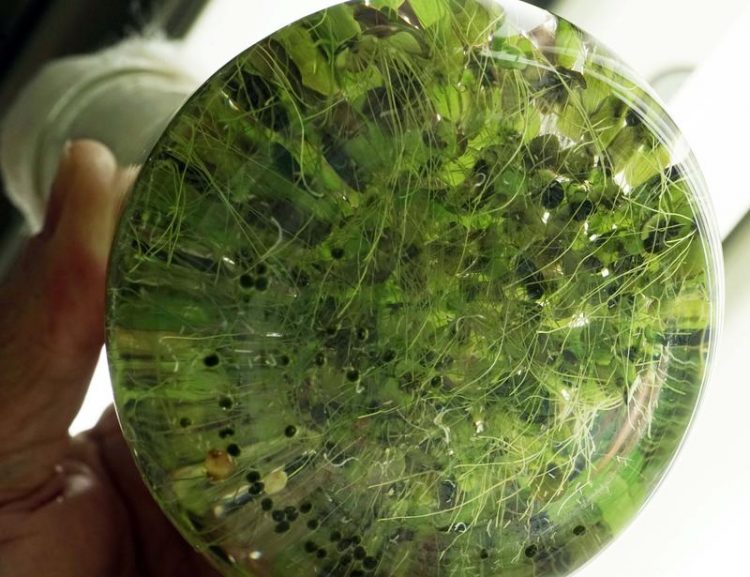Tiny plants with huge potential

Duckweed has a huge potential as a human food source. Photo: Jan-Peter Kasper/FSU Jena
Wolffia globosa, a tiny, rootless duckweed, or water lens, apparently has what it takes to achieve great things.
Researchers at the University of Jena (Germany), together with colleagues in India and Germany, have investigated the potential of various duckweeds as a human food source. The results, which are very promising, have been published under the title ‘Nutritional value of duckweeds (Lemnaceae) as human food’ in the leading journal ‘Food Chemistry’.
“Duckweeds can definitely serve as a source of protein in human nutrition,” says Prof. Gerhard Jahreis of the Friedrich Schiller University Jena. It is not without reason that duckweeds are dubbed ‘green machines’, the nutritional scientist adds. Jahreis explains that the protein content of duckweeds is comparable to that of lupins, rape or peas, with a protein yield of 30 per cent of dry weight.
What is more, these tiny plants contain valuable omega-3 fatty acids such as stearidonic acid and alpha-linolenic acid. Possible uses for duckweeds would be in the ever-popular smoothies or gluten-free baked goods.
“Duckweeds multiply very rapidly, but do not require any additional cultivable land,” says Dr Klaus Appenroth, associate professor at Friedrich Schiller University Jena. In view of the decrease in areas of farmland, this gives duckweed a huge advantage over soya, for example. For thousands of years, duckweed species have been on the menu in Asian countries such as Thailand, Cambodia and Laos.
As a plant physiologist, Appenroth has dedicated nearly his entire research career at the University Jena to the tiny plants, and he has built up an extensive collection of Lemnaceae (commonly known as duckweeds or water lenses), among other things. He singles out in particular the species Wolffia globosa, which is served up in Asia in the form of soup, as a vegetable or in omelette. In the latest tests by the research group, Wolffia globosa showed itself to be the most promising.
As yet these duckweeds have not been cultivated, but simply ‘harvested’ from bodies of water. However, there are some initial experimental facilities in Israel and the Netherlands, where duckweeds are produced on an industrial scale. Wolffia globosa measure only 0.7 to 1.5 mm, are oval in shape and rootless.
They multiply so rapidly that in a short time they can cover the entire surface of a body of water. A further argument in favour of having these plants as part of the human diet is that duckweeds easily absorb trace elements that are dissolved in water. This means that with little expense and effort, they can be used to relieve deficiency symptoms due to malnutrition.
Other potential applications for duckweeds are fish farming and water purification. The minute plants could also be used for producing bio-ethanol.
Original publication:
Klaus-J. Appenroth, K. Sowjanya Sree, Volker Böhm, Simon Hammann, Walter Vetter, Matthias Leiterer, Gerhard Jahreis: ‘Nutritional value of duckweeds (Lemnaceae) as human food’; Food Chemistry; DOI: 10.1016/j.foodchem.2016.08.116
Contact:
Dr Klaus Appenroth (Privatdozent, Associate Professor)
Institute of General Botany and Plant Physiology of Friedrich Schiller University Jena
Dornburger Straße 159, 07743 Jena, Germany
Phone: ++49 3641 / 949233
E-mail: Klaus.Appenroth[at]uni-jena.de
Prof. Gerhard Jahreis
Institute of Nutrition of Friedrich Schiller University Jena
Dornburger Straße 24, 07743 Jena, Germany
Phone: ++49 3641 / 949610
E-mail: b6jage[at]uni-jena.de
Media Contact
All latest news from the category: Life Sciences and Chemistry
Articles and reports from the Life Sciences and chemistry area deal with applied and basic research into modern biology, chemistry and human medicine.
Valuable information can be found on a range of life sciences fields including bacteriology, biochemistry, bionics, bioinformatics, biophysics, biotechnology, genetics, geobotany, human biology, marine biology, microbiology, molecular biology, cellular biology, zoology, bioinorganic chemistry, microchemistry and environmental chemistry.
Newest articles

Bringing bio-inspired robots to life
Nebraska researcher Eric Markvicka gets NSF CAREER Award to pursue manufacture of novel materials for soft robotics and stretchable electronics. Engineers are increasingly eager to develop robots that mimic the…

Bella moths use poison to attract mates
Scientists are closer to finding out how. Pyrrolizidine alkaloids are as bitter and toxic as they are hard to pronounce. They’re produced by several different types of plants and are…

AI tool creates ‘synthetic’ images of cells
…for enhanced microscopy analysis. Observing individual cells through microscopes can reveal a range of important cell biological phenomena that frequently play a role in human diseases, but the process of…





















